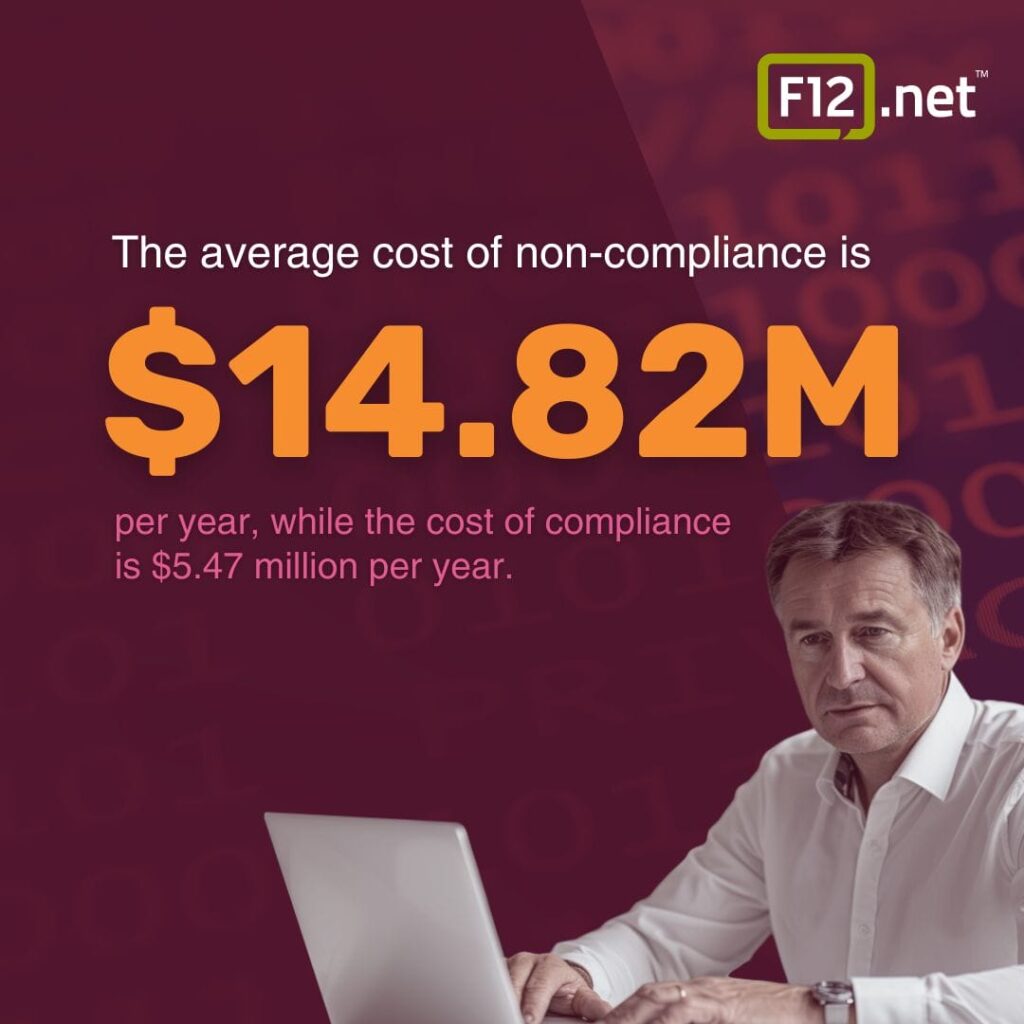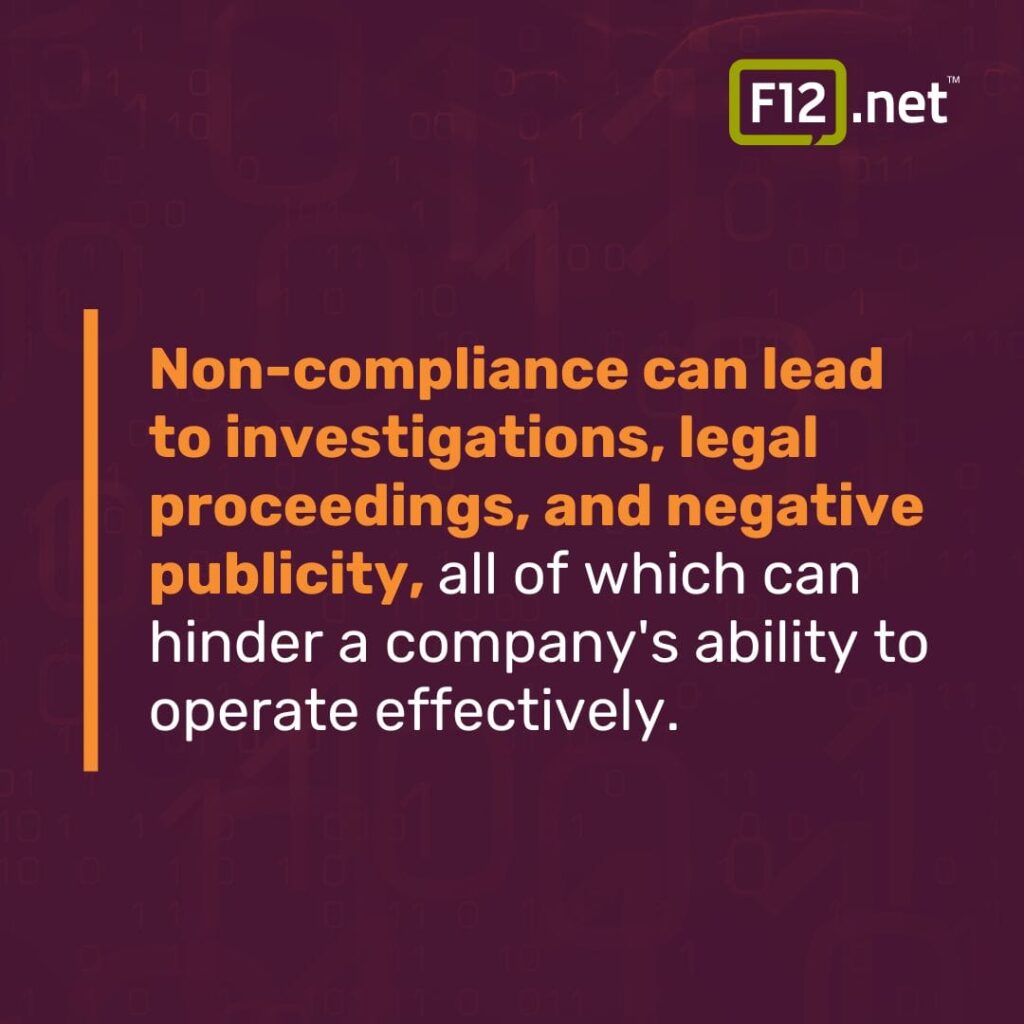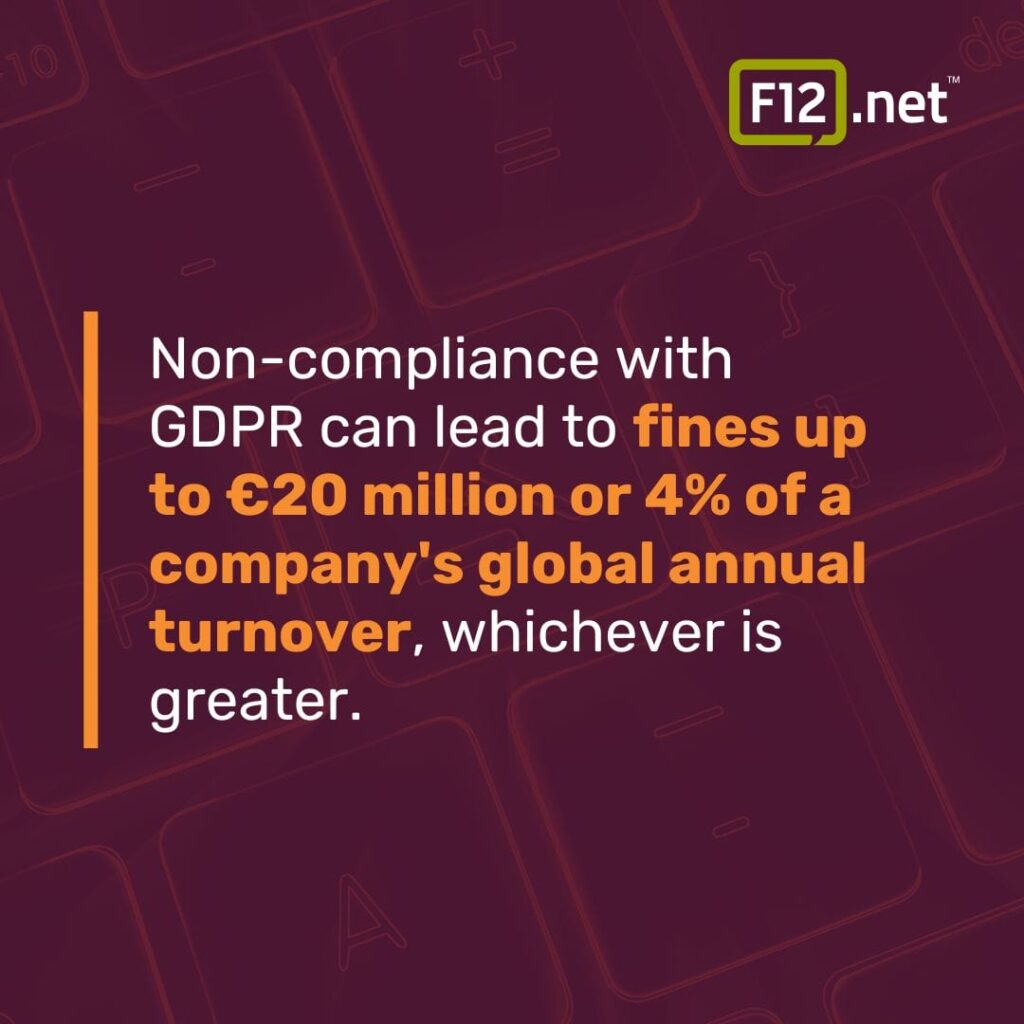Brief: Learn the importance of regulatory compliance and how managed IT services help meet these requirements. Understand how managed IT addresses compliance challenges, protects data, and supports ongoing regulatory needs for your business.
“Tonight, I will speak directly to these people and make the situation perfectly clear to them. The security of this nation depends on complete and total compliance.”
— Sutler, V for Vendetta 2006
While dystopian, Sutler’s statement highlights a crucial point: compliance is key to security and stability.
In business regulatory compliance is just as important.
Failure to comply can lead to hefty fines, legal trouble, and significant damage to your reputation.
For many businesses, especially smaller ones, keeping up with these regulations can be challenging.
That’s where managed IT services come in.
These experts help businesses meet industry-specific regulations, whether in healthcare, finance, or e-commerce.
They do this by setting up strong data security measures, performing regular audits, and keeping up with the latest standards.
For example, the 2017 Equifax data breach exposed the personal information of 147 million people and resulted in a $700 million fine due to failures in security and compliance.
This example shows the importance of having strong IT support to prevent such breaches and avoid significant financial and reputational damage.
In this article, we’ll explore 7 proven ways managed IT can help your business stay compliant and avoid the pitfalls of non-compliance.
What is Regulatory Compliance in Business?
- Regulatory compliance ensures businesses adhere to laws and guidelines
- Non-compliance can lead to legal consequences and reputational damage
- Managed IT services help businesses explore complex compliance requirements
Regulatory compliance refers to the process of ensuring that businesses follow all relevant laws, regulations, guidelines, and specifications set by governing bodies within their industry.
Compliance is essential for businesses to operate legally and ethically while protecting the interests of their customers, employees, and stakeholders.
Failure to comply with regulations can result in severe consequences, such as hefty fines, legal penalties, and reputational damage.
In some cases, non-compliance can even lead to the suspension or revocation of a business’s operating license. Therefore, it is crucial for businesses to understand and adhere to the regulatory requirements specific to their industry.
Examples of Regulatory Compliance
Different industries are subject to various regulations that businesses must follow. Some common examples of regulatory compliance include:
HIPAA Compliance in Healthcare
The Health Insurance Portability and Accountability Act (HIPAA) sets standards for protecting sensitive patient information in the healthcare industry.
Healthcare providers, health plans, and business associates must implement appropriate safeguards to ensure the confidentiality, integrity, and availability of protected health information (PHI).
PCI DSS Compliance in E-commerce
The Payment Card Industry Data Security Standard (PCI DSS) is a set of security standards designed to ensure that all companies that accept, process, store, or transmit credit card information maintain a secure environment.
E-commerce businesses must comply with PCI DSS to protect customer payment data and prevent data breaches.
SOX Compliance in Finance
The Sarbanes-Oxley Act (SOX) is a federal law that establishes standards for financial reporting and internal controls for public companies.
SOX compliance aims to prevent corporate fraud and protect investors by ensuring the accuracy and reliability of financial statements.
Types of Regulatory Compliance
Regulatory compliance can be categorised into different types based on the nature of the regulations and the industries they apply to.
Industry-Specific Regulations
Many industries have their own set of regulations that businesses must adhere to.
For example:
- Healthcare: HIPAA and the Health Information Technology for Economic and Clinical Health (HITECH) Act regulate the healthcare industry.
- Finance: SOX, the Gramm-Leach-Bliley Act (GLBA), and PCI DSS are some of the key regulations in the finance sector.
- E-commerce: PCI DSS and the General Data Protection Regulation (GDPR) apply to e-commerce businesses.
Data Security and Privacy Regulations
With the increasing importance of data privacy, several regulations have been introduced to protect consumer data.
Some notable examples include:
- GDPR in the European Union: GDPR sets strict requirements for businesses that collect, process, or store personal data of EU citizens.
- California Consumer Privacy Act (CCPA): CCPA gives California residents more control over their personal information and requires businesses to be transparent about their data practices.
- Personal Information Protection and Electronic Documents Act (PIPEDA) in Canada: PIPEDA governs how businesses collect, use, and disclose personal information in the course of commercial activities.
Benefits of Meeting Regulatory Compliance with Managed IT
- Avoid costly fines and legal penalties
- Protect sensitive data and customer trust
- Maintain business continuity and reputation
Avoiding Costly Fines and Legal Penalties
Failing to meet regulatory compliance requirements can result in significant financial consequences for businesses. Fines for non-compliance can range from thousands to millions of dollars, depending on the industry and the severity of the violation.
In addition to monetary penalties, non-compliant companies may face legal action, which can lead to further expenses and reputational damage.
According to a study by CornerStone, the average cost of non-compliance is $14.82 million per year, while the cost of compliance is $5.47 million per year.
Another study by Ponemon Institute found that the average cost of compliance for multinational organisations is $3.5 million per year, while the cost of non-compliance is $9.4 million per year.
Managed IT services help businesses identify and address compliance gaps before they become costly issues. By conducting regular audits and monitoring systems, managed IT providers can detect potential non-compliance and take corrective action.
This proactive approach minimises the risk of fines and legal penalties, allowing businesses to focus on their core operations without worrying about the financial repercussions of non-compliance.

Protecting Sensitive Data and Customer Trust
Regulatory compliance often revolves around the proper handling and protection of sensitive data, such as personal information, financial records, and confidential business data.
Managed IT services implement strong data security measures to ensure that this information remains secure and compliant with relevant regulations.
By adhering to compliance standards, businesses demonstrate their commitment to protecting customer information. This, in turn, helps to build trust and loyalty among customers, who are increasingly concerned about the privacy and security of their data.
In an era where data breaches can have devastating consequences for both businesses and individuals, meeting regulatory compliance is crucial for maintaining customer confidence and protecting the company’s reputation.
Implementing Data Security Measures
Managed IT providers employ a range of security measures to protect sensitive data, including:
| Security Measure | Description | Benefits |
| Encryption | Encrypting data both at rest and in transit ensures that even if a breach occurs, the information remains unreadable to unauthorised parties. | Protects data from unauthorised access. |
| Access controls | Implementing strict access controls, such as multi-factor authentication and role-based access, limits the risk of unauthorised access to sensitive data. | Reduces the risk of data breaches. |
| Monitoring and alerting | Continuous monitoring of systems and networks allows for the early detection of potential security threats or compliance issues, enabling prompt response and mitigation. | Improves incident response and minimises downtime. |
Maintaining Business Continuity and Reputation
Meeting regulatory compliance requirements helps businesses avoid disruptions caused by legal issues or security breaches. Non-compliance can lead to investigations, legal proceedings, and negative publicity, all of which can hinder a company’s ability to operate effectively.
By staying compliant, businesses can maintain their focus on core operations and growth strategies without the distraction of legal troubles.
Furthermore, compliance improves a company’s brand image and customer confidence. In today’s competitive market, customers are more likely to choose businesses that prioritise data security and regulatory compliance.
By demonstrating a strong commitment to meeting these standards, companies can differentiate themselves from competitors and build a reputation as a trustworthy and reliable partner.

Enabling Better Risk Management and Decision-Making
Regulatory compliance requires businesses to have a thorough understanding of their data, processes, and potential risks.
Managed IT services help organisations gain a clearer picture of their compliance by conducting assessments, generating reports, and providing insights into areas that need improvement.
This improved visibility enables better risk management and decision-making.
With a clear understanding of their compliance status, businesses can prioritise investments, allocate resources effectively, and make informed decisions about their IT infrastructure and security measures.
This, in turn, helps organisations stay agile and responsive in the face of evolving regulatory requirements and market conditions.
Facilitating Collaboration and Partnerships
Many industries require businesses to demonstrate compliance with specific regulations before engaging in partnerships or collaborations.
For example, in the healthcare sector, organisations must comply with HIPAA regulations to share patient data with other providers or work with third-party vendors.
By meeting regulatory compliance standards, businesses can more easily create collaborations and partnerships with other compliant organisations. This opens up new opportunities for growth, innovation, and expanded service offerings.
Managed IT services help businesses maintain the necessary level of compliance to take advantage of these opportunities and remain competitive in their respective markets.
How Managed IT Assists with Regulatory Compliance Requirements
- Managed IT providers have in-depth knowledge of industry-specific regulations
- They implement strong data security measures and conduct regular compliance audits
- Managed IT generates detailed reports to demonstrate compliance to regulatory bodies
Expertise in Industry-Specific Regulations
Managed IT providers make it their mission to stay up-to-date on the latest regulatory requirements specific to their clients’ industries.
Whether it’s HIPAA for healthcare, PCI DSS for e-commerce, or GDPR for businesses handling EU citizen data, managed IT teams have the expertise to guide businesses in meeting these complex compliance standards.
They work closely with clients to understand their unique compliance needs and develop customised strategies to ensure all necessary controls are in place.
This includes conducting thorough assessments to identify potential compliance gaps and recommending solutions to address them.
With their deep understanding of the regulatory world, managed IT providers serve as valuable partners in the world of compliance.
Implementing Data Security and Privacy Controls
One of the key aspects of regulatory compliance is ensuring the security and privacy of sensitive data. Managed IT providers play a crucial role in implementing and maintaining the necessary controls to protect this data from unauthorised access, breaches, and leaks.
This includes setting up strong firewalls to prevent unauthorised network access, encrypting data both at rest and in transit, and implementing strict access controls to ensure only authorised personnel can view or modify sensitive information.
Managed IT teams also develop secure data storage and disposal procedures to prevent data from falling into the wrong hands.
In addition to these technical controls, managed IT providers also assist with developing and enforcing data privacy policies and procedures.
They train employees on proper data handling practices and conduct regular security awareness training to ensure everyone understands their role in maintaining compliance.
Compliance Monitoring and Reporting
Achieving regulatory compliance is not a one-time event, but an ongoing process that requires continuous monitoring and reporting. Managed IT providers conduct regular audits to identify and address any compliance risks or vulnerabilities.
These audits may include vulnerability scans, penetration testing, and reviews of access logs to ensure all controls are functioning as intended. If any issues are identified, the managed IT team works quickly to implement corrective actions and prevent potential compliance violations.
Managed IT providers also generate detailed reports to demonstrate compliance to regulatory bodies and auditors. These reports include documentation of all security controls, data handling procedures, and employee training programs.
By providing this level of transparency, managed IT helps businesses build trust with regulators and customers alike.
The Importance of Regulatory Compliance in IT
Regulatory compliance has become a critical concern for businesses across all industries.
With the increasing reliance on technology and data, companies must ensure they are adhering to the relevant regulations and standards to protect sensitive information and maintain the trust of their customers and stakeholders.
Regulatory compliance refers to the process of ensuring that a company’s policies, procedures, and practices align with the specific laws, regulations, and standards that apply to their industry. This can include requirements related to data privacy, security, financial reporting, and more.
In a regulatory environment, IT plays a significant role in enabling businesses to meet these compliance requirements.
From implementing secure data storage and transmission protocols to monitoring for potential breaches or violations, IT systems and processes are essential for maintaining compliance.
Failing to adhere to regulatory requirements can result in severe consequences for businesses, including hefty fines, legal action, reputational damage, and loss of customer trust.
For example, non-compliance with GDPR can lead to fines up to €20 million or 4% of a company’s global annual turnover, whichever is greater. In some cases, non-compliance can even lead to the suspension or revocation of a company’s license to operate.
By partnering with a managed IT provider that specialises in regulatory compliance, businesses can ensure they have the expertise and resources necessary to explore regulations and standards.
This allows them to focus on their core operations while having peace of mind that their IT systems and processes are supporting their compliance efforts.

7 Ways Managed IT Helps Meet Regulatory Compliance
- Managed IT providers offer comprehensive risk assessments and gap analysis to identify compliance issues
- They implement secure IT infrastructure, data encryption, and access control systems
- Continuous monitoring and employee training ensure ongoing compliance and security
Comprehensive Risk Assessment and Gap Analysis
Managed IT providers start by conducting a thorough risk assessment of an organisation’s IT systems and processes. This involves identifying potential vulnerabilities, threats, and areas of non-compliance with relevant regulations.
The assessment covers all aspects of the IT environment, including hardware, software, networks, data storage, and user practices.
Once the assessment is complete, the managed IT provider performs a gap analysis to determine the difference between the current state of compliance and the desired state.
This analysis helps prioritise the areas that need immediate attention and guides the development of a comprehensive compliance strategy.
Benefits of Risk Assessment and Gap Analysis
- Identifies potential security risks and compliance issues before they become serious problems
- Provides a clear roadmap for addressing compliance gaps and improving overall security
- Helps allocate resources effectively by prioritising the most critical areas of concern
Implementing Secure IT Infrastructure and Controls
Based on the findings of the risk assessment and gap analysis, managed IT providers implement secure IT infrastructure and controls to address identified vulnerabilities and ensure compliance with relevant regulations.
This includes:
- Hardening systems and networks: Configuring firewalls, intrusion detection/prevention systems, and other security tools to protect against unauthorised access and attacks.
- Implementing data backup and recovery: Ensuring that critical data is regularly backed up and can be quickly restored in the event of a disaster or breach.
- Applying security patches and updates: Keeping all systems and software up-to-date with the latest security patches to address known vulnerabilities.
Best Practices for Secure IT Infrastructure
- Follow industry standards and frameworks, such as NIST, ISO, and CIS, for guidance on implementing secure IT controls
- Regularly review and update security controls to keep pace with evolving threats and regulatory requirements
- Document all security measures and processes for auditing and reporting purposes
Data Encryption and Secure Communication Protocols
Managed IT providers implement data encryption and secure communication protocols to protect sensitive information from unauthorised access or interception.
This includes:
- Encrypting data at rest: Using strong encryption algorithms, such as AES, to protect data stored on servers, databases, and other storage devices
- Encrypting data in transit: Implementing secure communication protocols, such as SSL/TLS, to protect data as it travels over networks
- Implementing secure email and messaging: Using encryption and other security measures to protect sensitive information sent via email or instant messaging
Importance of Data Encryption
- Ensures the confidentiality and integrity of sensitive information, even if it falls into the wrong hands
- Helps meet regulatory requirements for protecting personal, financial, and health information
- Builds trust with customers and partners by demonstrating a commitment to data security
Access Control and User Management Systems
Managed IT providers implement access control and user management systems to ensure that only authorised users can access sensitive information and systems.
This includes:
- Implementing role-based access control (RBAC): Assigning users to specific roles with defined permissions based on their job responsibilities.
- Enforcing strong password policies: Requiring users to create complex passwords and regularly update them to prevent unauthorised access.
- Implementing multi-factor authentication (MFA): Requiring users to provide additional forms of authentication, such as a fingerprint or security token, to access sensitive systems and data.
Benefits of Access Control and User Management
- Prevents unauthorised access to sensitive information and systems
- Helps meet regulatory requirements for protecting personal, financial, and health information
- Enables organisations to quickly revoke access for terminated employees or contractors
Incident Response and Disaster Recovery Planning
Managed IT providers develop and implement incident response and disaster recovery plans to minimise the impact of security breaches or other disruptive events.
This includes:
- Creating an incident response plan: Documenting the steps to be taken in the event of a security breach or other incident, including roles and responsibilities, communication protocols, and escalation procedures.
- Developing a disaster recovery plan: Identifying critical systems and data, establishing recovery time objectives (RTOs) and recovery point objectives (RPOs), and creating a step-by-step plan for restoring operations in the event of a disaster.
- Regularly testing and updating plans: Conducting periodic tests and simulations to ensure that incident response and disaster recovery plans are effective and up-to-date.
Importance of Incident Response and Disaster Recovery Planning
- Minimises the impact of security breaches and other disruptive events on business operations
- Helps meet regulatory requirements for business continuity and data protection
- Demonstrates a proactive approach to risk management and builds trust with customers and partners
Employee training on Security and Compliance
Managed IT providers offer employee training on security and compliance best practices to ensure that all users understand their roles and responsibilities in protecting sensitive information and maintaining compliance.
This includes:
- Providing regular security awareness training: Educating employees on common security threats, such as phishing and social engineering, and how to identify and report them.
- Conducting compliance-specific training: Providing targeted training on the specific regulatory requirements that apply to the organisation, such as HIPAA, PCI-DSS, or GDPR.
- Offering ongoing support and resources: Providing employees with access to security and compliance resources, such as reference guides, FAQs, and helpdesk support.
Benefits of Employee Training
- Reduces the risk of human error or negligence leading to security breaches or compliance violations
- Create a culture of security and compliance awareness throughout the organisation
- Helps meet regulatory requirements for employee training and awareness
Continuous Monitoring and Improvement of Compliance
Managed IT providers continuously monitor an organisation’s compliance and work to identify and address any new vulnerabilities or areas of non-compliance.
This includes:
- Conducting regular security audits and assessments: Performing periodic audits and assessments to ensure that security controls and compliance measures remain effective over time.
- Monitoring for new threats and vulnerabilities: Using threat intelligence and other resources to stay up-to-date on the latest security threats and vulnerabilities, and taking proactive steps to mitigate them.
- Implementing continuous improvement processes: Establishing processes for reviewing and improving security and compliance measures based on lessons learned from incidents, audits, and assessments.
Benefits of Continuous Monitoring and Improvement
- Ensures that security and compliance measures remain effective in the face of evolving threats and regulatory requirements
- Enables organisations to quickly identify and address new vulnerabilities or areas of non-compliance
- Demonstrates a commitment to ongoing security and compliance to customers, partners, and regulators
Choosing the Right Managed IT Provider for Compliance
- Look for providers with industry-specific experience and certified professionals
- Ensure they’re familiar with relevant regulations and have a strong security track record
- Assess their communication skills and ability to provide clear reports and updates
Look for Providers with Experience in your Industry
When selecting a managed IT provider to help meet compliance requirements, it’s crucial to find one that has experience working with businesses in your specific industry.
Different industries have unique regulations, and a provider well-versed in your sector’s compliance needs can offer targeted solutions.
For example, healthcare organisations must adhere to HIPAA regulations, while financial institutions need to comply with PCI DSS and GLBA.
Ensure they have Certified Professionals (CISA, CRISC, CISM)
Look for managed IT providers that employ professionals with relevant certifications such as Certified Information Systems Auditor (CISA), Certified in Risk and Information Systems Control (CRISC), and Certified Information Security Manager (CISM).
These certifications demonstrate a provider’s expertise in assessing, managing, and mitigating IT risks and ensuring compliance.
Verify Their Familiarity with Relevant Regulations
In addition to industry-specific experience, it’s important to verify that a managed IT provider is well-versed in the specific regulations that apply to your business.
They should have a deep understanding of the requirements, deadlines, and potential penalties associated with non-compliance.
Ask potential providers about their experience helping clients meet regulations such as GDPR, CCPA, HIPAA, SOC 2, or others that are relevant to your business.
Assess their Security and Compliance Track Record
When evaluating managed IT providers, ask for case studies or references from clients in regulated industries. Look for examples of how they’ve helped businesses improve their security, pass compliance audits, and avoid penalties.
By selecting a managed IT provider with the right industry experience, certified professionals, regulatory knowledge, and proven track record, businesses can feel confident in their ability to meet evolving compliance demands.
A trusted provider will serve as a strategic partner, offering expert guidance and support to help mitigate risks and achieve compliance goals.
Partnering with Managed IT for Regulatory Compliance Success
Managed IT services provide the expertise, tools, and strategies businesses need to explore the challenges of regulatory compliance.
By assessing risks, implementing secure infrastructure, encrypting data, controlling access, planning for incidents, training employees, and continuously monitoring compliance, managed IT providers help organisations avoid costly fines, protect sensitive data, and maintain their reputation.
When choosing a managed IT provider, look for experienced professionals who understand your industry’s specific regulations and have a proven track record of ensuring compliance.
By partnering with the right managed IT provider, your business can confidently meet regulatory requirements and focus on its core objectives.
Ready to strengthen your organisation’s regulatory compliance?
Schedule a consultation with our managed IT experts to discuss how we can help you achieve compliance success.
Which regulatory compliance challenges is your business currently facing?



